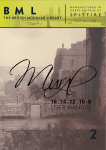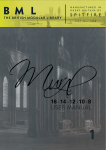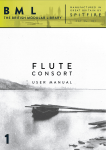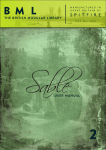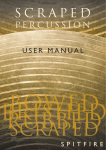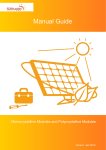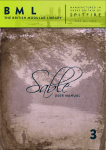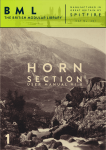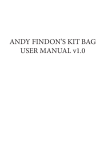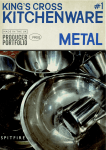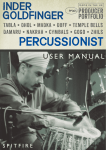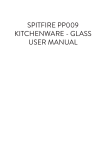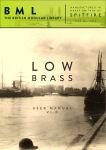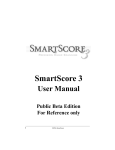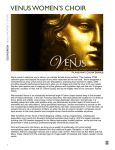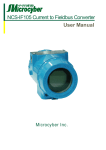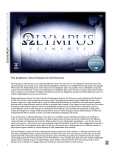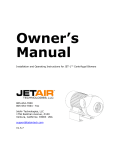Download VOLUME#4
Transcript
BML SABLE VOLUME#4 USER MANUAL (PRINTER FRIENDLY) USER MANUAL WELCOME Thanks for purchasing BML Sable Volume 4. The fourth of our definitive deeply sampled chamber string range. A new gold standard in orchestral sampling. We strongly urge you to read this manual as the BML range is packed with features not found yet in some of our other products. We have conveniently introduced a new to the manual “Blakes Pages” written by our scripting genius Blake Robinson, these discuss basic new features alongside some deeper features that we’re very excited about. These are from his blog on http://blake.so and better describe these features than we ever could! Please view these in the separately bundled .pdf or at: http://blake.so/blog/?11 About Spitfire Audio: Spitfire was formed in 2008 by a group of successful British composers as a means of producing the tools they needed for their busy work schedules. Sick of dry, humourless, ugly, unrealistic enormously untamable sounding libraries, Spitfire set about redefining the way samples were created. Our aim is to reproduce the conditions of top movie recording sessions and approach sampling as if we were recording a film score one note at a time. We don’t imitate how film scores are recorded, we replicate them by using the same facilities, signal chain, techniques and musical & technical talent. We record performances, and parts thereof, not scientifically created samples and importantly we record the room they play in. If you are wanting perfectly tuned, normalised or “dry” samples you have probably come to the wrong place. For here you may find the odd string squeak, a “fruity” note, and lots and lots of “room” but put the whole package together, write some beautiful music and suddenly this library and our approach will make perfect sense. In thanks to using the greatest talent we have available to us in the UK alongside the greatest facilities and technicians, Spitfire Audio supports the British music industry by paying the highest rates possible to it’s contributors alongside a royalty based on the success of sales. So in buying this software you are also supporting British musicians, studios and technicians and we thank you for that. About The British Modular Library: The British Modular Library is to be a deeply sampled, extensive set of tools providing composers with the ability to add fine aspects of extreme detail, musical expression, beauty and focus to their work. To greater understand the instruments your writing for. To encourage you to write music that musicians love to play and to get the most out of smaller ensembles and the wealth of timbral colour and character they can add to any project. Recorded the “SPITFIRE WAY” and showcasing the finest musicians in the UK today playing the rarest and most priceless instruments. The BML will demonstrate why London is the oft preferred scoring location for composers the world over. After many years of development experience Spitfire will present this library with a user interface and set of features unprecedented in any library to date. With 7 mic positions, recorded at 96k through vintage valve and ribbon mics to 2” tape through custom Neve “Monserrat” preamps and Prism convertors at the hall in Air-Studios, one of the greatest scoring stages in the world. With different stereo and 5.1 mixed versions from our chief engineer Jake Jackson the library is designed to be scalable for a variety of systems, from your laptop on the red-eye from NY to LA to your multi slaved rig back at your studio compound! BM L C A T. 3 0 4 THE B R I T ISH MODUL A R LI BRA RY PA G E 2 Sable 4 304 Sable VOLUME #4 THE FAMILY JUST GOT A LITTLE BIGGER After a decade of enjoying the delights of enormous string libraries, providing broad brush stroke approaches to writing, which have successfully dominated film, gaming and TV music to a large extent, Spitfire are at last proud to present a new set of brushes. The finest of sable brushes if you will, to provide you with the tools you need to write detailed and focussed string parts that have a personality and style that represents your personality, that expresses your creative will and provides you with fresh pastures of experimentation. Spitfire presents SABLE. The complete Sable band will feature 4 x 1st Violins, 3 x 2nd Violins (totally different players seated in their correct positions), 3 x Violas, 3 x Cellos and 3 x Basses. A band that provides you with ultimate detail and clarity. A library where you can hear every player. Where each player has been hand picked for their individuality and the rarity of their instrument. This range will move people not with scale but the beauty of what you’re inspired to write when playing it. Want to go bigger? Well our plan all along was that Albion would provide the perfect backdrop for Sable when needing larger scale. Arrange an Albion part and duplicate with an instance of Sable (we have even designed some instrument group presets so you can do this automatically) and slowly dial it in to add that beautiful edge to your arrangements (see page 18). Sable 4 features our Sable band playing “more extended articulations”. With the clarity in sound of this band, but also the breadth of Sampling, the depth, the length of the Articulation list! We hope that this ushers in a new era of meticulous string writing and the promotion of smaller bands into the forefront of people’s imagination. In its use we only have one recommendation. Whilst Sable will work in a pad like ensembles unison tutti fashion (where it will start sounding quite big), it will really come into its own when you imagine each section as a different voice. By writing truly contrapuntal music you will find Sable takes you to beautiful pastures fresh and new! Before putting the keys in the ignition just a quick word on musicians. Without them we wouldn’t have this library. Its designed to help us all write better music for them to play. To hire smaller bands and have them play material that is appropriate to their size. To encourage people who have never written strings to dive in with confidence. We are not here to do away with musicians (we wouldn’t pay them a voluntary royalty from sales if we were!). So whenever you can, please go live, even if its one or two players. A single double tracked violin on the top line can make all the difference so even if the budget doesn’t permit, ask your producer or director to see what they can find down the back of the sofa. BM L C A T. 3 0 4 THE B R I T ISH MODUL A R LI BRA RY PA G E 3 Sable 4 CONTENTS SPECIFICATIONS5 LETS GET STARTED6 THE OVERVIEW PANEL7 THE PANEL SWITCHER8 ARTICULATIONS9 MICS & MIXES11 THE EXPERT PANEL13 GENERAL CONTROLS 14 EXPRESSION CONTROLS15 ADVANCED - MIXER16 ADVANCED - POLYPHONIC LEGATO 17 ADVANCED - ARTICULATIONS18 ADVANCED - SIDE BAR20 ADVANCED - THE COG21 UACC22 BM L A COUPLE OF TROUBLESHOOTS 23 A QUICK THANK YOU 24 C A T. 3 0 4 THE B R I T ISH MODUL A R LI BRA RY PA G E 4 Sable 4 SPECIFICATIONS KONTAKT BML is NOT a Kontakt Player library, so you WILL need a full version Kontakt to run it. PLEASE MAKE SURE YOU HAVE THE LATEST VERSION OF EITHER KONTAKT 4.2.4 OR 5 INSTALLED. Because this module doesn’t authorise through the NI Service Centre and is personally watermarked, you will be able to install on all the machines you own. Owning a full version of Kontakt will afford you the luxury of being able to edit and revise the patches to your particular preference. Remember we pride ourselves in making truly esoteric tools, so if there’s a sample you don’t like, you can change it for another with relative ease (check out the new Punch Cog on page 15 to see how you can easily do this). RECOMMENDED SPEC: The better your computer, the better the performance of any Spitfire module. But not to worry if you’re not spec’d up to the hilt. All programs are provided with a set of parameters that enable you to tone back the CPU demands of any given patch. But moving forward, we’re confident this module will keep your computer busy for many years to come! We recommend a combination of high processor speeds, a good chunk of memory and a devoted 7200rpm eSata, USBII, Thunderbolt, or Firewire audio drive. The more memory you have, the less demand placed on your drive, and having a totally devoted drive gives you the chance to load less into memory and reduce load times. The higher the speed of your CPU, the more capable your computer will be to deal with some of the amazing, but complicated scripts we’ve written. PCs: We recommend Windows 7 (latest Service Pack, 32/64 Bit), Intel Core Duo or AMD Athlon 64 X2, 2 GB RAM (4 GB recommended). MACs: We recommend Mac OS X 10.6, 10.7 or 10.8 (latest update), Intel Core 2 Duo, 2 GB RAM (4 GB recommended). DRIVES: Firewire, USBII, or eSata, 7200rpm. Ask your dealer for drives that are suitable for “AV use”. We always recommend as small a drive as possible, as the platter will be smaller and the seek time less. Depending on what mic positions and mixes you download the library will eventually take up 20-120 Gig on your hard drive. If using several large libraries, or a number of Spitfire modules from the same machine, we really recommend having your samples distributed over a number of drives. Lacie eSata or Quadras 7200rpm we highly recommend. Moreover, an exciting development lies in the recent arrival of some amazing solid state (SSD) drives. With seek times reduced to a fraction (0.1ms vs 6-9ms) of what standard drives can offer, we are certain you will be able to reduce your sampler’s “pre-load” (page 15.) buffer tenfold meaning you’ll be able to load enormous orchestral palettes into a single machine. HOST: The Kontakt 4 platform should work comfortably on most commonly found platforms and DAWs. As always make sure you’re as up-to-date as you can afford! If you’re planning on building or adding Spitfire to an already large orchestral palette, we recommend running your library independently of your DAW, either on your host computer (e.g. via Re-Wire) or on a slave device (e.g.. via Midi or MOL). This will assist your loading times, and will allow your DAW to do what it does best, sort out all your note ons and note offs! We heartily endorse Plogue Bidule (www.plogue.com) as a virtual rack/ routing system. For more advice and information about setting up please check our website. BM L C A T. 3 0 4 THE B R I T ISH MODUL A R LI BRA RY PA G E 5 Sable 4 LETS GET STARTED Because you’re reading this manual, we can presume you have successfully downloaded your BML product. Included in your download email are some detailed installation instructions, please follow these carefully before going any further. We’ll see you back here, when you’re installed! Before opening Kontakt please make sure you have THE LATEST VERSION OF KONTAKT 4.2.4 OR 5 INSTALLED. 95% of all service enquiries relating to spurious or strange behaviour of our wares are solved by installing the most recent version. As this is NOT a Kontakt Player Library YOU WILL NOT SEE THE MODULE IN THE LIBRARY PANE. Simply navigate to MURAL via the “File” browser pane. If you have never used Kontakt before we wholeheartedly recommend your familiarise yourself with the basics of patch (or instrument) loading, multi management, outputting and MIDI routing detailed in the Kontakt user-manual provided with your copy of Kontakt or in the “documentation” folder of your Kontakt file. BML SABLE Vol. 4 FOLDER STRUCTURE Most users of volume 4 will be familiar with Sable folder structures. But these are currently undergoing a revolutionary overhaul. For more information on new palettes and combining your Sable library please visit our site and Blake’s fantastic blog: http://blake.so/blog/?11 for more genius concepts. BM L C A T. 3 0 4 THE B R I T ISH MODUL A R LI BRA RY PA G E 6 Sable 4 THE NEW “OVERVIEW” PANEL MIC/ MIX POSITIONS EXPRESSION CONTROLS PANEL SWITCHER ARTICULATIONS BM L C A T. 3 0 4 THE B R I T ISH MODUL A R LI BRA RY PA G E 7 Sable 4 PANEL SWITCHER This toggles between the three different views available in BML101. 1. 2. 3. 1. OVERVIEW - The default GUI with a selection of easy to use parameters (Page 7). 2. EXPERT - The familiar Spitfire GUI with deeper tweaking parameters (Page 13). 3. THE OSTINATUM - Our ingenious and inspiring rhythm sequencer (Page 22). BM L C A T. 3 0 4 THE B R I T ISH MODUL A R LI BRA RY PA G E 8 Sable 4 ARTICULATIONS ARTICULATION STANZA On the right of the diagram above you will see a line of musical notes. These actually denote key articulations, display the current articulation playing and act as switches between them (alongside they’re associated keyswitches). We have created a series of presets with different articulations loaded (SEE PRESETS IN GENERAL CONTROLS PAGE 14). LOAD TOGGLES - The little RAM chips beneath the notes denote load status of the articulations. If you play and articulation that isn’t loaded the front panel will alert you. Click on the chip to load/ unload. i Make sure Kontakt displays the instrument load status as pictured. If the left hand bar is illuminated and red it’s in a queue and hasn’t started loading yet, if the middle bar is lit and yellow the instrument is still loading up. If you try to play before it’s loaded it may not be nice! ARTICULATIONS - Click on these notes to select the different articulations, whatever articulation is live is displayed in the yellow sidebar on the left. You can also select different articulations by hitting key switches, you can do this whilst you’re playing so if you want to say switch from a “long” articulation to a short, hit the key whilst you’re playing your last long and the next note will be a short. For more advanced selection options turn to page 18. A brief guide to these articulations is displayed overleaf... BM L C A T. 3 0 4 THE B R I T ISH MODUL A R LI BRA RY PA G E 9 Sable 4 A BRIEF GUIDE Long Sul Pont CS Long articulations bowed close to the bridge with practice mutes on for a fantastically haunting and fragle sound. Long Sul G Longs played just on the G string for a fantastically expressive and unique sound. Long Sul Tasto One of the most heart breaking and fragile sounds where the bow is placed higher up on the neck closer to the fingers for an amazingly intimate whisper of a tone. Tremolo CS From Herrmann’s score for Psycho con sordino (playing with practice mutes engaged) has been adopted by the film world as an effective tool for creating expressive string music without overpowering it’s screen presence. Here we expand your Sable con sord pallette with som CS tremolandos. Tremolo Sul Pont CS As above but with a slightly more haunting tone bowed up near the bridge. Legato (Sul G) As with the longs here’s a monophonic legato patch. An extraordinary way to interpret your top lines! Longs Sul Pont Distorted (CB only) Played so close to the bridge that the sound starts to collapse and create incredible harmonics. In addition to this we complete the additional articulations for the CB with Tremolando Sul Pont, Longs Flautando, Trills major and minor found for the rest of the band on Sable 1,2,&3. BM L C A T. 3 0 4 THE B R I T ISH MODUL A R LI BRA RY PA G E 1 0 Sable 4 MICROPHONE/ MIX SETTINGS Welcome to the wonderful world of Air Studios and the mixes of our chief engineer Jake Jackson. Use the chips beneath the faders to load unload different microphones and the faders above to tweak the balance of them. Turning a fader all the way down will also unload the mics, conversely turning the fader back up will reload. Left click on the faders to assign CC controllers so you can mix these live for fantastic shifts in the spacial nature of the samples. MICROPHONES / MIXES Right/ Ctrl click on the mic letters to change Kontakt channel/output assignment. STANDARD ARRAY: C - Close mics, a selection of valve mics placed for optimum focus close to the instruments. This mic control is great to add in for added definition and at times a bit of “rounding of sound”, in isolation it can be a way of achieving a more intimate or pop-music style sound. T - Tree. This refers to the “Decca” tree of three mics placed above the conductors podium. In the case of Sable; 3 priceless vintage Neumann M50s. These are placed to give the ultimate sound of the band, the hall and are the default mic position that loads in with each patch. A - Ambient. A set of condenser mics placed high up in the gallery away from the band. This mic position gives a massive amount of stereo spread and room sound over the band. Great mixed in with the other mics but also ideal fed to your Ls & Rs speaker sends for true surround information. O - Outriggers, a set of vintage mics placed wide apart to the left and right of the tree. These give a similar balance of room and band but with a broader stereo spread. The effect of this mic is somewhere between the tree and ambient mics. L - Leader microphone, placed closer to the leader for that slightly more traditional perspective. This is recorded at the same time as the rest of the band so there is spill. But for the larger instruments (where the body produces more sound to eclpise the other players) this spill is minimal so these mics can be used as an excellent mockup tool for solos. EXTENDED ARRAY: ST - Stereo Mic. These are totally different mics in a totally different position to the tree (closer to ground level) and have a more direct and immediate sound than the tree. G - Gallery mics, three mics at the very furthest point from the band way up in the gallery. A true representation of Air-Studios’ amazing ambience. CR - Close ribbons. Placed next to the standard close mics but using a rarefied selection of vintage ribbon mics to add a warm and rounded tone. JAKE JACKSON MIXES : 3 extraordinary mixes from our chief engineer to save your system resources B - Broad, a cinematic/ symphonic mix that allow the hall to really speak out. M - Medium, a more intimate but still very classic version of the mix above. F - Fine, a much more detailed and immediate sound with less hall, great for pop! BM L C A T. 3 0 4 THE B R I T ISH MODUL A R LI BRA RY PA G E 1 1 Sable 4 EXPRESSION CONTROLS Key controllers for BML, right click (on a PC) or command click (on a mac) to change which MIDI #CC controls them. For more details about these and other expression controllers go to page ** BM L C A T. 3 0 4 THE B R I T ISH MODUL A R LI BRA RY PA G E 1 2 Sable 4 THE “EXPERT” PANEL GENERAL CONTROLS BM L C A T. 3 0 4 THE B R I T ISH MODUL A R LI BRA RY PA G E 1 3 EXPRESSION CONTROLS Sable 4 GENERAL CONTROLS OPTIONS PRESETS - This allows you to load predetermined sets of articulations affectionately called articulation sets (see page 5) quickly and easily to optimise your system quickly for essential articulations or to start building templates using empty “shells”. PURGE UNUSED - This control keeps unloading any samples you are not using to keep your memory usage as low as possible. TRANSPOSE - Toggle this on and tweak the number to the right to transpose your instrument. Note this is not the same as tuning, the instrument will actually offset the samples to the selected pitch. A great way to “track up” BML and make it sound bigger! CC MAPPED VEL(OCITY) - Click this to control note velocity with the Dynamics slider. If a user has customer the dynamics slider, that same customised CC will control velocity now. ROUND ROBINS & LEGATO NO EXTRA FUNCTIONALITY (NEIGHBOURING ZONES)- Next to this lies a pop-down menu with some amazing new functions: • “No extra Functionality” - Is the standard default where round robins are used as they were intended. • “Neighbouring Zones” - pulls from neighbouring zones, so for an ‘8RR’ instrument, you effectively cycle through up to 24 different sounding notes when pressing a key. It’s still just playing the one RR at a time, though giving you more of them. In legato mode this also alternates between 3 legato intervals to give a fake round robin. • “2x Round Robin With Skip” - plays two RR simultaneously, so you get a thicker sound, it’s the equivalent of plopping two notes on top of each other in your DAW (and it drops the overall volume ~6db so that the levels remain the same but it just sounds thicker). NB THIS IS NOT AVAILABLE TO LEGATO TRANSITIONS. This plays the pairs and moves ahead by 2 RR. In this mode RR is effectively halved. eg, if you press a note it would play RR1/RR2 then RR3/RR4 ,etc. • “Layer 2x Round Robins With No Skip” - As above but this plays a pair but doesn’t move ahead by 2 so that RR isn’t halved. So if you press a note it would play RR1/RR2, then RR2/RR3, then RR3/RR4. ROUND ROBINS - This refers to the number of round robins (multiple recordings of the same notes that cycle around as you repeatedly play a note) your instrument uses, the number can be dragged up and down (1-8) to save you memory. RESET FROM F0 - This enables you to control the round robin cycle (so it sounds identical every time you play) toggle on & play the key selected (default F0) to reset. RESET ON TRANSPORT - As above but resets every time you press play! Genius! SHORT ARTICULATIONS RT - This new option allows you to toggle whether staccato/tenuto/marcato notes have a release trigger that plays on release. This lets you tighten up staccatos or end marcatos/tenutos earlier than they were recorded. BM L C A T. 3 0 4 THE B R I T ISH MODUL A R LI BRA RY PA G E 1 4 Sable 4 EXPRESSION CONTROLS Mural comes with a fantastic new selection of expression controls. Dial these CC’s into your midi controller for an infinate choice of emotional and human responses. DYNAMICS - CC#1 This slider displays and controls which dynamic layer is live. Also controlled via the modulation wheel. VIBRATO - CC#21 This mixes between vobrato and non, or senza vibrato. SPEED - CC#16 Controls legato interval speed. Great to use when playing the lines into your DAW for more responsive less laggy control. Dial back on playback for greater realism. INTENSITY - CC#15 This is a great way to vary and humanise the legato articulations. Dial it all the way up for a more pronounced emotional start to each note, dial it back for a more transparent transition. RELEASE - CC#17 Dial all the way for slow passages when using long articulations, it helps blur the transition in a natural and musical way. Dial back for more focus and detail. TIGHTNESS - CC#18 We proudly cut our samples from the true beginning of the note, as the bow engages the string and the rosin begins to weave it’s magic. The net effect of this is laggy and sometimes very small inconsistencies in timing. Which we love! It Sounds real! But it’s not to everyone’s taste. This ingenious device allows you to tighten and loosen to your heart’s content. An excellent use of this is to dial it all the way to the right in order to play your part in. Once you’re happy adjust to taste and put a negative delay in the track header of your DAW which is the same amount as the Tightness setting. EXPRESSION - CC#11 Displays the overall instrument volume (0-100%). Remember you can also trim your instrument volume with CC#7. BM L C A T. 3 0 4 THE B R I T ISH MODUL A R LI BRA RY PA G E 1 5 Sable 4 ADVANCED STUFF - MIXER MENU 1. 2. 3. 4. CLICK ON THESE ICONS FOR DEEPER MIX CONTROL: 1. VELOCITY RESPONSE Pick from 4 different velocity curves to suit your controller. 2. CLOSE MIC PAN COLLAPSER The close mics are a stereo mix and this collapser allows you to refine how the stereo image is handled. All our musicians are recorded in-situ, ie where they would be seated on a standard scoring session, giving you a fantastic spectral spread when putting all the elements together, which helps define the detail. This panning tool helps you to manage and tweak this to your own tastes/ needs. STEREO WIDTH - Allows you to control how far the stereo image reaches. All the way to the right would be like having your two pan pots panned hard. All the way to the left would be like having both pots centre, STEREO PAN - Then allows you to control where in the pan field the centre of this image is placed. 3. MICROPHONE MIX TO ARTICULATION LINKER The small notation symbol locks the microphone mix or tweak you’ve made to the articulation selected. This means if you want to boost any perceived inconsistencies in volume between say pizzicato and col legno you can. Or indeed if you want to roll off some of the hall ambience for a short versus the long articulations this is how to fine tune. 4. MIXER PRESETS A new way to transfer mixer settings between patches, or save and load presets to disk. AUTOMATING MIXER FADERS - Each mixer fader has a dedicated #CC. To change this to suit your MIDI controller or surface, simply right click (on PC) or command click (on Mac) on the fader itself to “learn” the new controller. ROUTING MIC MIXES - To route each mic ixer channel to unique Kontakt channels simply click on the Mic acronym. Great for putting your ambient mics in the surround for example. Also good for tracklaying individual mics for your engineer to control in your final mix sessions. For more information regarding Kontakt audio channels & routing please consult your Kontakt User Manual. BM L C A T. 3 0 4 THE B R I T ISH MODUL A R LI BRA RY PA G E 1 6 Sable 4 ADVANCED STUFF - PLOYPHONIC LEGATO Polyphonic legato enables you to effectively divisi a single section. Or in layman’s terms, play more than one note with the legato articulations. The way BML determines which line is transitioning to which note is via velocity. So this is very much a “post-prod” tool which you’ll need to tweak to get your orcehstrations how you like them. To enable click on the button and adjust the number to how many voices you wish to have (2-8). BML then divides the velocity range (127) by this number to determine which voice is transisting to which. Once you’ve played your arrangement in (maybe by using a longs articulation) go into your DAW and “normalise” all your velocity values. Then simply lassoo each voice and alter the velocity to assign it a voice grouping. For convenience here’s a table of the ranges determined by numbers of voices. Polyphony 2 3 4 5 6 7 8 BM L Range 1 - 63 1 - 42 1 - 31 1 - 25 1 - 21 1 - 18 1 - 15 C A T. 3 0 4 THE B R I T ISH MODUL A R LI BRA RY 64 - 127 43 - 84 32 - 63 26 - 50 22 - 42 19 - 36 16 - 32 85 - 127 64 - 95 51 - 76 43 - 63 37 - 54 33 - 47 96 - 127 77 - 101 64 - 84 55 - 72 48 - 63 PA G E 1 7 102 - 127 85 - 105 106 - 127 73 - 90 91 - 108 109 - 127 64 - 79 80 -95 96 - 111 112 - 127 Sable 4 ADVANCED STUFF - ARTICULATION SELECTION LAYERING: To layer sounds within the articulation set simply ‘SHIFT’ click on your next articulation. Rather than introducing a multitude of more confusing ‘layered articulation’ options, the front panel shows (and edits) only the most recently layered articulation. TRIGGERING: For triggering options CTRL or COMMAND click on the articulation icon: “By CC Range” - This will allow you to use a single controller channel to switch between artics. This allows you to fine tune on your MIDI event list, or to use a midi controller fader or indeed button with a single range assigned to select your desired artic’. Our default setting is guided by our UACC protocol (see page 25). “By KS” - The default setting. BML is scripted so it won’t switch mid note but wait ‘til the next not-on event before switching. This means you’re able to play the key switch say whilst playing a long note and have it switch to a staccato on your next note. “By Velocity Range” - This is great for designing intelligent staccato patches that say become staccatissimo when you hit the keyboard really hard. A second menu will open up giving you options for this function. “By MIDI Channel” - Ingeiously turns your single instance of BML into a multi timbral instrument. MIDI channel lets the instrument change articulation based on the incoming MIDI channel. To use, pop the instrument Midi Ch. to ‘Omni’ mode in Kontakt. The single instance can now be configured to play based on the incoming MIDI channel. For example. Set staccatos to channel 1, longs to channel 2 , legato to channel 3. “By Speed Of Playing” - A revolutionary new function that allows you to switch articulations based on the playing speed of your performance. When selected, it provides options to specify a triggering time-range in milliseconds. (See right hand menu above). For example, you could specify that ‘fast legato’ should be activated if the time between playing each interval is between 0 and 250ms (pictured above). Fully configurable to suit the user’s playing style and needs and can be deactivated by unchecking ‘Enabled’ (or if not in the artic switching screen, simply holding ALT/MENU and clicking the articulation icon on the stanza). BM L C A T. 3 0 4 THE B R I T ISH MODUL A R LI BRA RY PA G E 1 8 Sable 4 TRIGGERING CONTINUED: When an articulation has a ‘trigger’ assigned to it, it shows a little shortcut icon above to let you know that it has been customised. Holding down ALT/MENU (PC/MAC) and clicking an articulation with this shortcut above it will toggle the trigger between enabled and disabled. It’s a handy way to quickly turn off legato speed/velocity switching if the user doesn’t want it. TRIGGER PANEL Reset will clear the trigger for this articulation, allowing you to set it to a different type or disable it permanently. Legato intervals only will only activate this trigger if the notes played are legato intervals. Ignore if purged means that this trigger will only occur if the articulation is not purged. Group allows you to group together triggers. When set, the trigger only occurs when an articulation in the same group is currently active. For example, use this if you wanted to set up speed triggers on legato articulations, but don’t want them to trigger if you have staccatos/marc/shorts selected. BM L C A T. 3 0 4 THE B R I T ISH MODUL A R LI BRA RY PA G E 1 9 Sable 4 ADVANCED STUFF - SIDE BAR OPTIONS 1. 2. 3. 4. 1. “THE COG” - An awesome tool for fine tuning and tweaking your patches. See page 18. 2. “KEYBOARD SHIMMIER” - This shifts your bank of keyswitches left or right to suit your needs preferences or performance. 3. “KEYSWITCH TO CC SELECTOR” - Use this to assign a CC controller to act as articulation/ keyswitcher. Click on “CC” and you’ll be prompted to move the controller you wish to use in order for the instrument to “learn” how you’d like to select articulations. 4. “ARTICULATION LOCKER” - We all like to select articulations and use our templates in different ways. Many composers like to have a single articulation loaded to each instance of an instrument for example. So its worth locking off the articulation switching once you’ve selected one so you don’t have sounds disappearing from slaves way off in your machine rooms! Unlocked Artic’ - Is the standard setting, select articulations via the front panel or associated keyswitch. Locked Artic’ - This locks your articulation so it doesn’t change either via front panel or keyswitch. Locked Keyswitch - This locks your articulation via keyswitch but you’re free to switch via the front panel. Locked to UACC - This is a new standard being developed by Spitfire and detailed on page 25. The default controller channel is #32 but this can be changed by right/ CTRL clicking on the padlock. BM L C A T. 3 0 4 THE B R I T ISH MODUL A R LI BRA RY PA G E 2 0 Sable 4 ADVANCED STUFF - THE PUNCH COG As we record our samples like you would a film score, we actively encourage our musicians to make every note sound different. To play with the flair that would be expected from them on a score shoot. We like tuning imperfections, little squeeks, the odd breath of a human! We like our pizzicatos loose and for the odd “rub” between players when playing transitions. However much we apply our exacting taste principals onto our range we’re never going to meet with everyone’s preferred quality bar, or needs and expectations of a project. So we present to you Blake Robinson’s coup de grace.... A way of punching notes in and out like we used to in the old days. A way of customising your library to fit your taste and needs. If there is a round robin you don’t like or a long note where the tuning is a bit fruity. Switch to the articulation you were using. Play until you find the Round Robin you don’t like and then stop. Observe the pictured cog bottom left of the front panel/ UI, and click on it to get this dialogue: HOW SHOULD WE TWEAK - Then your last note played will be displayed, if this is correct get tweaking. SKIP THIS RR - Will simply make it always jump along to the next round robin in the cycle. ADJUST TUNE/ VOL - Will adjust the tuning and or volume of the last played note. ADJUST RELEASE - This will alter the level of the release trigger (which will effect the percieved decay of that note). SAMPLE START - If it feels loose adjust to the right, tight adjust to the left (NB this is only available in full “cog” patches). REMOVE ALL NOTE TWEAKS - This removes all custom changes you have made with the Cog. BM L C A T. 3 0 4 THE B R I T ISH MODUL A R LI BRA RY PA G E 2 1 Sable 4 UACC UNIVERSAL ARTICULATION CONTROLLER CHANNEL We finally admit that things have got out of hand here in the world of Virtual instruments. Every single one works differently, responds differently to different key switches and controllers, and thats just within our own library! The UACC (pron’ you-ack) project is our attempt to unify articulation switching across our entire range and it’s one we hope other developers will also adopt. It will mean greater integration between your VI set templates, greater encouragement to venture into the darker, less visited corners of your collection and a smoother workflow. When selecting “Articulation Locked To UACC” you disable what we believe to be the soon-outdated keyswitch method of articulation selection. In favour of UACC which defaults to channel #32 (change this by right-clicking the CC slider next to the padlock). This then gives you the option of using a MIDI controller to select articulations based on the list below. We recommend a switch based controller or an iPad app. Alternatively simply dial in event or automation data on your DAW. The latter will give you the ability of always being on the correct articulation, even if you haven’t rolled your sequence back before the midi event. This list is a work-in-progress and we look to users and other developers to finalise it. Go to here for the latest version: http://spitfire-webassets.s3.amazonaws.com/pdfs/UACCv2spec.pdf BM L C A T. 3 0 4 THE B R I T ISH MODUL A R LI BRA RY PA G E 2 2 Sable 4 A COUPLE OF TROUBLESHOTS This is a manual to accompany v1.0 of a totally new line for Spitfire. With a totally new set of samples, scripts, and UI. We have used our experience as busy film composers to deliver something that we’d like. It is our hope that you keep in touch with us to let us know how you’re getting on, how you’re using BML, how you’re finding it, and, if we were to consider looking at areas in the future, what you’d like us to look at. From this we’ll form a consensus and wholeheartedly pledge that we will act upon it wherever possible or practical. We’ve already recorded new material which will be distributed for free in service updates. We do this because, even after years of experience, it’s not always easy to predict how things turn out. So we leave space in our budgets to go back and record stuff that may not have worked as well as we like, may need expanding upon, or to widen the scope of something that’s surprised us and we want to make more of. Keep an eye on your in-box and our site for new additions to the BML range and others and of course our site. A couple of commonly asked questions... • This library really isn’t behaving how I’d expect. - OK, so we’re now officially blue in the face. But before you go ANY further please check you are using the ABSOLUTE latest version of Kontakt. Visit your trusty service centre and we hope this page remains relatively under-thumbed. • My instrument or patch seems to be playing just bits of sound, some keys are missing, and there’s lots of clicks and crackles. - Make sure that your patch is fully loaded (detailed on the front panel, page 8). Some of these are biggies so can take a while. But if problems persist make sure Kontakt memory manager is activated: then: You’ll have to restart this instance of Kontakt to feel it’s benefits. Another reason your system may be struggling is that you’re using too many mics live for the spec of your machine. Try cutting the mics as detailed on the front panel to see if this cures your problem. If it does, don’t worry you can still use these mics, just play in your parts with one active (we recommend the T(ree)) and then activate multiple mics and render down (eg. freeze function in Logic Studio). Some DAWS (ahem, Logic) only use one core of your computer when recording but will use more when playing back so again try recording with just one mic then dial in others once you’re happy. If you’re still suffering may we suggest you try and manage your pre-load buffer. Kontakt pre-loads some samples into memory so that when you hit a note Kontakt plays it out from RAM whilst addressing the rest of your samples from your hard drive(s). The slower your drives, the more you may want to rely on RAM, the faster the drives, or smaller RAM available, the more you may want to rely or your drives. If you’re using the latest generation of SSDs you’ll find you can radically reduce your pre-load buffer. Referring to the plate above tick the “Instruments Default Pre-Load Buffer Size” and drag the fader to a setting you’re happy with. BM L C A T. 3 0 4 THE B R I T ISH MODUL A R LI BRA RY PA G E 2 3 3 Sable 4 A QUICK THANKS Christian & Paul would like to thank Dominic Kelly, Alison Burton and the whole of the Air Studios team. To Jake Jackson for making everything sound so marvellous, and the remarkable talents, immense intellect and invention of James Bellamy, Stanley Gabriel, Andrew Blaney, Blake Robinson, Stu Kennedy, Joe, Toby, Seb, Patrick, Cicely, Brett and Jess. Most of all we would like to thank the amazing support and loyalty of our user-base, our Facebook friends and everyone at VI Control. We are in the same boat as all of you. We’re not content and software developers by trade, so appreciate your honesty in paying your way to be a part of our family and not distributing this illegally. But more importantly, if you have any ideas or criticism please let us know directly via our website in a constructive manner. You never know, you just may have thought of something that we hadn’t considered. We want to make our entire range the best there is, and we rely on you to help us achieve that..... With thanks. Christian & Paul. COPYRIGHT SPITFIRE AUDIO LLP 2014 www.spitfireaudio.com BM L C A T. 3 0 4 THE B R I T ISH MODUL A R LI BRA RY PA G E 2 4 Sable 4
























